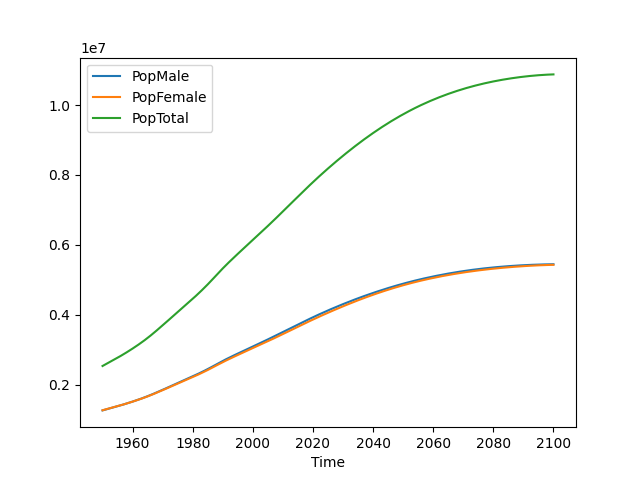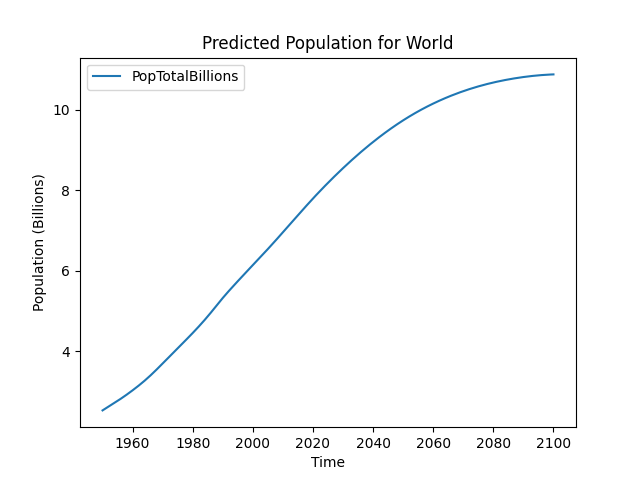Material in Unit 6 is optional. You are not expected to know this for a test and there are no labs or projects using this material.
Introduction to pandas
This guide shows you the basics of using pandas to plot data.
If you are writing code on your own machine, be sure to install pandas first:
pip install pandasYou can view a Google Colab notebook of this guide page.
Reading a CSV file into a dataframe
One of the nicest things about pandas is you can read data from a CSV file. In fact, you can read files directly over the Internet by providing a URL for the file.
data = pd.read_csv(filename_or_URL)The result of reading the CSV is a dataframe, which is a two-dimension representation of your data — just like a spreadsheet.
You can take a look at the first few lines of the dataframe using data.head().
import pandas as pd
world_pop = pd.read_csv("https://raw.githubusercontent.com/zappala/intro-to-pandas/main/world-population.csv")
print(world_pop.head())This will show the first five rows of the dataframe:
LocID Location VarID ... PopFemale PopTotal PopDensity
0 900 World 2 ... 1270171.462 2536431.018 19.497
1 900 World 2 ... 1293796.589 2584034.227 19.863
2 900 World 2 ... 1317007.125 2630861.690 20.223
3 900 World 2 ... 1340156.275 2677609.061 20.582
4 900 World 2 ... 1363532.920 2724846.754 20.945
[5 rows x 10 columns]This data comes from a collection of world population data provided by the United Nations. It’s a really large file, with separate data for every country from 1950 onward, so I have created a smaller set of it that provides just the population data for the entire world.
You can look at the last few lines of the data with:
print(data.tail())This will show the last five rows of the datframe:
LocID Location VarID ... PopFemale PopTotal PopDensity
146 900 World 2 ... 5418979.294 1.085811e+07 83.464
147 900 World 2 ... 5422249.024 1.086361e+07 83.506
148 900 World 2 ... 5425118.647 1.086835e+07 83.542
149 900 World 2 ... 5427571.318 1.087228e+07 83.573
150 900 World 2 ... 5429588.256 1.087539e+07 83.596
[5 rows x 10 columns]Notice that the data goes to the year 2100! All the data after the current year is a projection.
Getting columns of the dataframe
You can get a single column of the dataframe by putting the name of the column in square brackets:
print(world_pop['PopTotal'])This will print:
0 2.536431e+06
1 2.584034e+06
2 2.630862e+06
3 2.677609e+06
4 2.724847e+06
...
146 1.085811e+07
147 1.086361e+07
148 1.086835e+07
149 1.087228e+07
150 1.087539e+07
Name: PopTotal, Length: 151, dtype: float64You can also get multiple columns from the dataframe:
print(world_pop[['Time', 'PopTotal', 'PopMale', 'PopFemale']])This will print:
Time PopTotal PopMale PopFemale
0 1950 2.536431e+06 1266259.556 1270171.462
1 1951 2.584034e+06 1290237.638 1293796.589
2 1952 2.630862e+06 1313854.565 1317007.125
3 1953 2.677609e+06 1337452.786 1340156.275
4 1954 2.724847e+06 1361313.834 1363532.920
.. ... ... ... ...
146 2096 1.085811e+07 5439132.293 5418979.294
147 2097 1.086361e+07 5441365.752 5422249.024
148 2098 1.086835e+07 5443228.989 5425118.647
149 2099 1.087228e+07 5444712.816 5427571.318
150 2100 1.087539e+07 5445805.463 5429588.256
[151 rows x 4 columns]Keep in mind that these return a new copy of the dataframe. The original is unchanged. So if you want to keep that copy, you need to store it in a variable.
total_population = world_pop[['Time', 'PopTotal']]
print(total_population.head())This prints:
Time PopTotal
0 1950 2536431.018
1 1951 2584034.227
2 1952 2630861.690
3 1953 2677609.061
4 1954 2724846.754Using specific rows from the dataframe
You can get specific rows from the data frame by putting the row number in square brackets:
print(world_pop.loc[1])This prints:
LocID 900
Location World
VarID 2
Variant Medium
Time 1951
MidPeriod 1951.5
PopMale 1290237.638
PopFemale 1293796.589
PopTotal 2584034.227
PopDensity 19.863
Name: 1, dtype: objectYou can get a set of rows and their columns by listing a range of rows and a set of columns:
print(world_pop.loc[1:10, ['Time', 'PopTotal']])This prints:
Time PopTotal
1 1951 2584034.227
2 1952 2630861.690
3 1953 2677609.061
4 1954 2724846.754
5 1955 2773019.915
6 1956 2822443.254
7 1957 2873306.058
8 1958 2925686.680
9 1959 2979576.147
10 1960 3034949.715You can get all the rows by using just ’:’ for the row specifier:
print(world_pop.loc[:, ['Time', 'PopTotal']])This prints:
Time PopTotal
0 1950 2.536431e+06
1 1951 2.584034e+06
2 1952 2.630862e+06
3 1953 2.677609e+06
4 1954 2.724847e+06
.. ... ...
146 2096 1.085811e+07
147 2097 1.086361e+07
148 2098 1.086835e+07
149 2099 1.087228e+07
150 2100 1.087539e+07
[151 rows x 2 columns]You can get a subset of rows by using boolean conditions:
print(world_pop.loc[(world_pop['Time'] >= 2010) & (world_pop['Time'] <= 2020), ['Time','PopTotal']])This prints:
Time PopTotal
60 2010 6956823.588
61 2011 7041194.168
62 2012 7125827.957
63 2013 7210582.041
64 2014 7295290.759
65 2015 7379796.967
66 2016 7464021.934
67 2017 7547858.900
68 2018 7631091.113
69 2019 7713468.205
70 2020 7794798.729Plotting a dataframe
Pandas makes it really easy to create plots from the data in a dataframe. Here is a simple line plot of the total population by year:
world_pop.plot(x='Time', y='PopTotal')This produces a plot:

If you want to save this to a file:
ax = world_pop.plot(x='Time', y='PopTotal')
figure = ax.get_figure()
figure.savefig('population.png')We can plot multiple lines at a time by providing multiple y values in a list:
world_pop.plot(x="Time", y=["PopMale","PopFemale","PopTotal"])This produces a plot:

Note that the male and female populations are nearly identical.
Sometimes we need to chain together multiple plots, and we can do that with the
axis returned by the plot() function:
ax = world_pop.plot(x="Time", y="PopMale")
world_pop.plot(ax = ax, x="Time", y="PopFemale")
world_pop.plot(ax = ax, x="Time", y="PopTotal")This produces the same plot as above.
Creating new columns
It can be useful to create new columns in the dataframe. Here we create a new column that converts the population in thousands to the billions.
world_pop["PopTotalBillions"] = world_pop["PopTotal"] / 1e6
print(world_pop.head())This prints:
LocID Location VarID ... PopTotal PopDensity PopTotalBillions
0 900 World 2 ... 2536431.018 19.497 2.536431
1 900 World 2 ... 2584034.227 19.863 2.584034
2 900 World 2 ... 2630861.690 20.223 2.630862
3 900 World 2 ... 2677609.061 20.582 2.677609
4 900 World 2 ... 2724846.754 20.945 2.724847
[5 rows x 11 columns]Adding labels to plots
We can specify additional parameters to plot() to modify the x labels, y
labels, and title.
world_pop.plot(
x='Time',
y="PopTotalBillions",
ylabel="Population (Billions)",
title="Predicted Population for World"
)This creates the plot:
